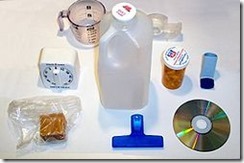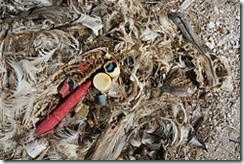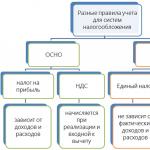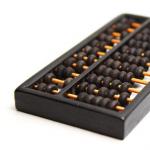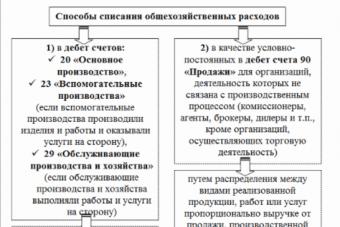Polypropylene (PP)- a colorless polymer related to thermoplastics - synthetic materials that change their plasticity when heated. Melting temperature 160-170 С, density 900-910 kg / m 3, elongation without destruction 200-400%, insoluble in organic solvents. Resistant to hot water (up to 130C) and aggressive environments, except for strong oxidants (concentrated nitric and sulfuric acids). In thin films, it is practically transparent (96%).
For material characterized by high impact strength, resistance to repeated bending, good wear resistance. The material does not conduct heat well, does not conduct electric current. Thin films, fibers and filaments are produced from granular material by extrusion. Distinguish two main methods of film extrusion: Blown hose extrusion and flat slit extrusion. The first method produces a film sleeve that can be folded or cut. If the incision is made in one or more places along the sleeve, then a so-called half-sleeve is obtained. Cutting the sleeve lengthwise from both sides, you can get a web. In the second method (flat-slit extrusion), a film web is obtained. The film can be non-oriented and oriented.
Orientation of films (orientation of molecules in a material) is achieved by stretching them in a heated state during extrusion. Of the oriented films, the most widely used is biaxially oriented (BOPP) film.
This film has a tensile strength 3-4 times that of non-oriented material.
Such films are frost-resistant down to -50C, high strength, wear resistance and elasticity at the same time. Biaxially oriented films due to their ability to withstand significant mechanical loads, they are used for packaging various food products and other industrial goods on automatic lines. As a disadvantage of BOPP films, it is possible to note the weldability worse than that of films made of non-oriented PP.
Non-oriented film is produced mainly by blown tube extrusion, and biaxially oriented using flat-slit extrusion.
Differences between propylene and polyethylene
The difference between polypropylene and polyethylene and other types of plastics lies in the lower density category, with high level resistance to impact the environment(that is, to light, temperature and oxygen). The strength of this material is higher, so the abrasion resistance is also increased. A change in mechanical properties is observed during the aging process of the material. From this polypropylene protect stabilizers, which are introduced to protect the material not only during use, but also during manufacture. An important quality of polypropylene is water resistance. Resistance to aggressive media, as well as environmental factors is confirmed by many experiments.
The melting point of this material is significantly higher than that of polyethylene; therefore, it is subject to heat treatment with steam and hot water without loss of properties. Also, polypropylene is characterized by a low level of electrical conductivity. A feature of the material is also frost resistance.
All these properties of polypropylene allow you to successfully use it as a packaging material. Its high strength and durability, as well as resistance to environmental factors, allows it to be used as packaging for food.
Polypropylenes differ in molecular structure - it can be isotactic, syndiotactic and atactic polypropylene. The chemical and physical properties of different types of material differ. The main properties possessed by polypropylene can be reflected in the following table.
Polymers and materials made from them, household items, equipment are an important part of industry and human life in general. Natural resources, unfortunately, have been greatly depleted during their use. Therefore, people had to learn how to synthesize artificial materials that have a number of important technical characteristics. One of these is polypropylene. The chemical formula of this compound, the features of its properties and the structure of the molecule will be considered in the course of the article.
Polymers - general characteristics
This class of compounds includes those that have a very high value. After all, polymers are complex organic compounds consisting of repetitive monomer units, which can be from several tens to hundreds, thousands and millions.
Among all polymers, the following groups can be distinguished:
- Natural origin - proteins, nucleic acids, ATP molecules, and so on.
- Artificial - those that are created on the basis of natural, but have been chemically modified in order to improve technical characteristics. For example, artificial rubbers.
- Synthetic - those that are created only by chemical reactions, synthesis in laboratories and industrial plants. Examples include synthetic fabrics and fibers, polyethylene, polyvinyl chloride, polypropylene, and others.
All designated groups of polymers are important industrial raw materials for the production and production of various equipment, household items, dishes, toys, furniture and other things.
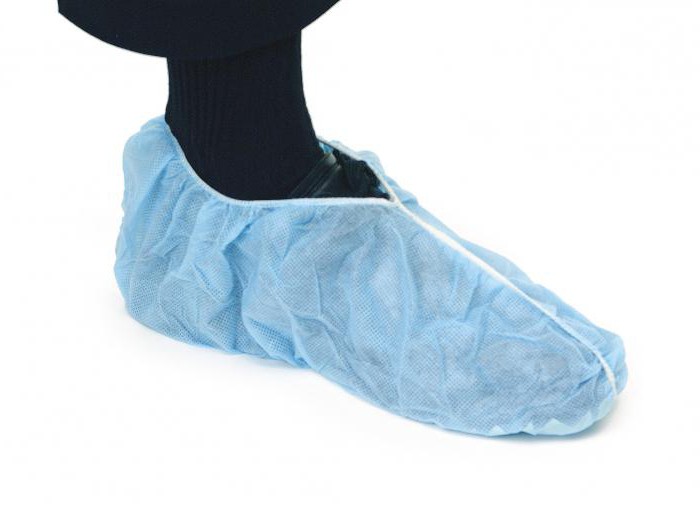
Representatives of the most important synthetic polymers
The chemical formula of one of the most important representatives of synthetic polymers is written as (-CH 2 -CH 2 -) n. This is polyethylene. The areas of its use are known. These are household needs (household film), and industrial and food industries (packaging material). However, although it is the most common, it is far from the only representative that is extremely important for humans. You can also name such polymers as:
- polyvinyl chloride;
- polypropylene;
- polyisobutylene;
- polystyrene;
- teflon;
- polyvinyl acetate and others.
It is in the construction business, as well as for the manufacture of dishes, such a material as polypropylene plays an important role. Therefore, further we will consider precisely its features from a chemical point of view.

Polypropylene formula
From the point of view of the science of chemistry, the composition of a given substance can be expressed different kinds formulas. The first option is molecular notation. In this case, the polypropylene formula looks like this: (C 3 H 6) n. The last n denotes the degree of polymerization, that is, the number of structural starting units in the macrochain.
Such a record allows one to draw a conclusion about the qualitative and quantitative composition of the molecule. Polypropene consists of carbon and hydrogen atoms, and their number in the monomer unit is 3/6, respectively, and in the total chain depends on the index n. If we talk about the very structure of the compound, about the order of the bonds of atoms in the molecule, then another type of recording of the substance is needed.

Polypropylene: structural formula
The type of record that shows the order in which atoms are joined in a molecule is called a structural formula. For the substance we are considering, it will look like this: (-CH 2 -CH-CH 3 -) n. It is obvious that the generally accepted valence of atoms in organic chemistry is retained in this case as well. The formula of polypropylene or polypropene indicates which monomer unit is the basis of the compound. It is formed from propene (alkene) or propylene. His empirical formula: C 3 H 8.
Starting monomer
The monomer formula for polypropylene production is as follows: (—CH 2 —CH — CH 3 -). If this fragment is repeated several hundred times, then we get a whole macromolecule, which is the material in question. In addition, we have already indicated that, in general, an ordinary alkene, propene, should be considered the starting material. He is a polypropylene monomer. will be written as CH 3 -CH = CH 2. When the double bond is broken during polymerization, the desired fragment is formed. The same monomeric unit that repeats itself forms a polymer macromolecule.
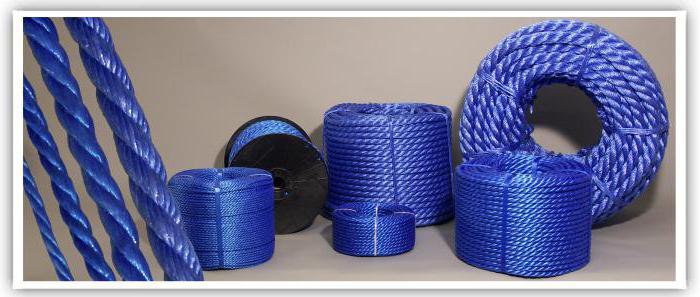
Physical and chemical properties
The formula of polypropylene (-CH 2 -CH-CH 3 -) n makes it possible to judge its physical and chemical characteristics. Let's list the main ones.
- Physical properties of this polymer: density 0.91 g / cm 3, hard, abrasion resistant, does not corrode. The color is white, opaque. There is no smell. It is insoluble in water and organic solvents at normal temperatures. When the index is over 100 0 С, it dissolves in hydrocarbon compounds. It begins to soften after 140 0 С, melts at 170 0 С. Possesses heat and frost resistance.
- Chemical properties. In terms of activity, polypropene can be classified as an almost inert substance. It is capable of interacting only with particularly strong oxidants: fuming nitric, chlorosulfonic acids, oleum, active halogens (fluorine, chlorine). It does not interact with water at all, even at elevated temperatures. It reacts with oxygen only when irradiated with ultraviolet light, the process is accompanied by the destruction of the polymer. In organic solvents, it swells and dissolves with increasing temperature.
The indicated properties can be attributed to the technical characteristics of the material itself, which is used in industry. However, not all polypropylene is created equal. There are special stabilizing additives with which different grades of the polymer in question are created.
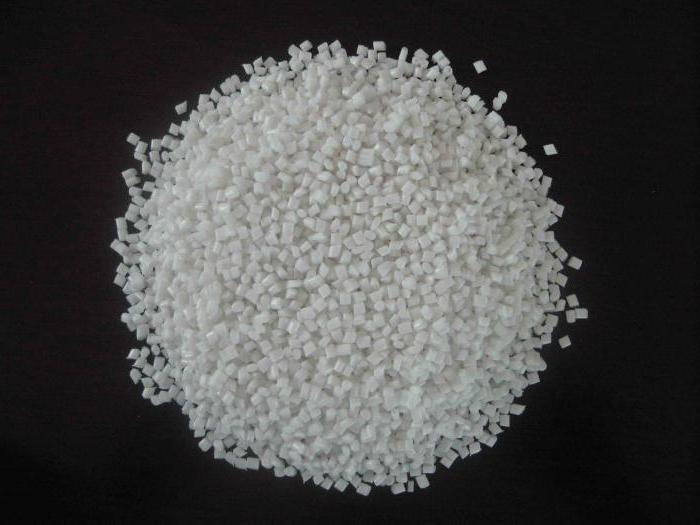
Material specifications
There are several basic properties that the polypropylene material possesses. Its characteristics are as follows:
- When heated, it is capable of melting, preliminarily softening.
- Does not have conductive properties.
- Shock-resistant, durable.
- Resistant to abrasion.
- It ages when exposed to the sun and oxygen, but the process is quite slow.
- As a polymer, it has a low molecular weight.
- It is white, translucent, tasteless and odorless.
- When burned, it does not emit harmful substances, it emits a light floral aroma.
- It is flexible, durable, resistant to various kinds of dirt.
- Possesses heat and frost resistance.
All the indicated properties of polypropylene as a material allow it to be used for various needs. It is easy to use, easy to maintain and use in practice in any branch of the national economy.
In total, there are three main types of this material:
- attacking;
- syndiotactic;
- isotactic.
The main difference in them is, specifically, the arrangement of methyl groups in the chain. Also on specifications stabilizing additives, the number of monomer units in the macrostructure have an effect.
This material is produced either in the form of crystalline granular structures, or in the form of fibers, sheets.

Areas of use
Polypropylene material is used for the production of various films, packaging containers, food containers. It is from it that ordinary plastic cups and other items of disposable tableware are made. This material is used to make durable, chemical-resistant polypropylene sanitary pipes.
It is also used to create noise-proof materials. Duct tape is also a type of polypropylene.
Attactic material is used to manufacture:
- mastic;
- adhesives;
- putty;
- sticky tapes;
- road surfaces and so on.
A large number of polypropylene sheets, fibers are used for the manufacture of toys, stationery, household and household items.
It is a waxy mass white(thin sheets are transparent and colorless). Chemically and frost-resistant, insulator, not sensitive to shock (shock absorber), softens when heated (80-120 ° C), solidifies when cooled, adhesion is extremely low. Sometimes in the popular mind it is identified with cellophane - a similar material of plant origin.
Receiving
For processing comes in the form of granules from 2 to 5 mm. Polyethylene is obtained by polymerizing ethylene:
High pressure polyethylene production
High pressure polyethylene(LDPE), or Low density polyethylene(LDPE) is formed under the following conditions:
- temperature 200-260 ° C;
- pressure 150-300 MPa;
- the presence of an initiator (oxygen or organic peroxide);
in autoclave or tubular reactors. The reaction proceeds by a radical mechanism. The polyethylene obtained by this method has a weight average molecular weight of 80,000-500,000 and a degree of crystallinity of 50-60. The liquid product is subsequently granulated. The reaction takes place in the melt.
Production of medium-pressure polyethylene
Medium Density Polyethylene(ESD) is formed under the following conditions:
- temperature 100-120 ° C;
- pressure 3-4 MPa;
- the presence of a catalyst (Ziegler-Natta catalysts, for example, a mixture of TiCl 4 and R 3);
the product falls out of solution in the form of flakes. The polyethylene obtained by this method has a weight average molecular weight of 300,000-400,000, a degree of crystallinity of 80-90%.
Getting low-density polyethylene
Low-pressure polyethylene(HDPE) or High density polyethylene(HDPE) is formed under the following conditions:
- temperature 120-150 ° C;
- pressure below 0.1 - 2 MPa;
- the presence of a catalyst (Ziegler-Natta catalysts, for example, a mixture of TiCl 4 and R 3);
Polymerization proceeds in suspension according to the ion-coordination mechanism. The polyethylene obtained by this method has a weight average molecular weight of 80,000-3,000,000, a degree of crystallinity of 75-85%.
It should be borne in mind that the names "low pressure polyethylene", "medium pressure", "high density", etc. have a purely rhetorical meaning. So, polyethylene obtained by methods 2 and 3 has the same density and molecular weight. The pressure during polymerization at the so-called low and medium pressures is in some cases the same.
Other methods of producing polyethylene
There are other methods of ethylene polymerization, for example, under the influence of radioactive radiation, but they have not received industrial distribution.
Polyethylene modifications
The range of ethylene polymers can be significantly expanded by obtaining copolymers of ethylene with other monomers, as well as by obtaining compositions by compounding one type of polyethylene with another type of polyethylene, polypropylene, polyisobutylene, rubbers, etc.
Numerous modifications can be obtained on the basis of polyethylene and other polyolefins - graft copolymers with active groups that improve the adhesion of polyolefins to metals, paintability, reduce its flammability, etc.
Modifications of the so-called "cross-linked" polyethylene PE-C (PE-X) stand apart. The essence of stitching is that the molecules in the chain are connected not only in series, but also side bonds are formed that connect the chains to each other, due to this, the physical and to a lesser extent Chemical properties products.
There are 4 types of cross-linked polyethylene (according to the production method): peroxide (a), silane (b), radiation (c) and nitrogen (d). The most widespread is PEX-b, as the fastest and cheapest in production.
Molecular structure
High pressure polyethylene macromolecules ( n≅1000) contain side hydrocarbon chains C 1 -C 4, medium-pressure polyethylene molecules are practically unbranched, there is a greater proportion of the crystalline phase in it, therefore this material is denser; low pressure polyethylene molecules occupy an intermediate position. The large number of side branches explains the lower crystallinity and, accordingly, the lower density of LDPE compared to HDPE and PESD.
|
Indicators characterizing the structure of the polymer chain of various types of polyethylene: |
|||
|
Index |
LDPE |
ESD |
HDPE |
|
The total number of CH 3 groups per 1000 carbon atoms: |
|||
|
The number of end groups CH 3 per 1000 carbon atoms: |
|||
|
Ethyl branches |
|||
|
The total number of double bonds per 1000 carbon atoms |
|||
|
including: |
|||
|
vinyl double bonds (R-CH = CH 2),% |
|||
|
vinylidene double bonds (),% |
|||
|
trans-vinylene double bonds (R-CH = CH-R '),% |
|||
|
Crystallinity,% |
|||
|
Density, g / cm³ |
Low pressure polyethylene (HDPE)
|
Physicochemical properties of HDPE at 20 ° C: |
|||||||||||||||||||||||||||||||||||||||||||||||||||||||||||||||||||||||||||||||||||||||||||||||||||||||||||||||||||||||||||||||||||||||||||||||||||||||||||||||||||||||||||
|
Parameter |
Meaning |
||||||||||||||||||||||||||||||||||||||||||||||||||||||||||||||||||||||||||||||||||||||||||||||||||||||||||||||||||||||||||||||||||||||||||||||||||||||||||||||||||||||||||
|
Density, g / cm³ |
|||||||||||||||||||||||||||||||||||||||||||||||||||||||||||||||||||||||||||||||||||||||||||||||||||||||||||||||||||||||||||||||||||||||||||||||||||||||||||||||||||||||||||
|
Breaking stress, kgf / cm² |
|||||||||||||||||||||||||||||||||||||||||||||||||||||||||||||||||||||||||||||||||||||||||||||||||||||||||||||||||||||||||||||||||||||||||||||||||||||||||||||||||||||||||||
|
under tension |
|||||||||||||||||||||||||||||||||||||||||||||||||||||||||||||||||||||||||||||||||||||||||||||||||||||||||||||||||||||||||||||||||||||||||||||||||||||||||||||||||||||||||||
|
under static bending |
|||||||||||||||||||||||||||||||||||||||||||||||||||||||||||||||||||||||||||||||||||||||||||||||||||||||||||||||||||||||||||||||||||||||||||||||||||||||||||||||||||||||||||
|
at cut |
|||||||||||||||||||||||||||||||||||||||||||||||||||||||||||||||||||||||||||||||||||||||||||||||||||||||||||||||||||||||||||||||||||||||||||||||||||||||||||||||||||||||||||
|
elongation at break,% |
|||||||||||||||||||||||||||||||||||||||||||||||||||||||||||||||||||||||||||||||||||||||||||||||||||||||||||||||||||||||||||||||||||||||||||||||||||||||||||||||||||||||||||
|
flexural modulus, kgf / cm² |
|||||||||||||||||||||||||||||||||||||||||||||||||||||||||||||||||||||||||||||||||||||||||||||||||||||||||||||||||||||||||||||||||||||||||||||||||||||||||||||||||||||||||||
|
tensile yield strength, kgf / cm² |
|||||||||||||||||||||||||||||||||||||||||||||||||||||||||||||||||||||||||||||||||||||||||||||||||||||||||||||||||||||||||||||||||||||||||||||||||||||||||||||||||||||||||||
|
elongation at the beginning of the flow,% |
It is insoluble at room temperature and does not swell in any of the known solvents. At elevated temperatures (80 ° C) we will dissolve in cyclohexane and carbon tetrachloride. It can be dissolved under high pressure in water overheated to 180 ° C. Over time, it degrades with the formation of cross-chain links, which leads to increased brittleness with a slight increase in strength. Unstabilized polyethylene undergoes thermal oxidative degradation (thermal aging) in air. Thermal aging of polyethylene proceeds by a radical mechanism, accompanied by the release of aldehydes, ketones, hydrogen peroxide, etc. Low-pressure polyethylene (HDPE) is used in the construction of waste disposal sites, storage facilities for liquid and solid substances that can pollute soil and groundwater. ProcessingPolyethylene (except ultramolecular) is processed by all methods known for plastics, such as extrusion, blow molding, injection molding, and pneumatic molding. Extrusion of polyethylene is possible on equipment with an installed "universal" worm. Application
Details of technical equipment, dielectric antennas, household items, etc.; Low-tonnage grade of polyethylene - the so-called "ultra-high molecular weight polyethylene", characterized by the absence of any low molecular weight additives, high linearity and molecular weight, is used for medical purposes as a replacement for cartilage tissue of joints. Despite the fact that it compares favorably with HDPE and LDPE in its physical properties, it is rarely used due to the difficulty of its processing, since it has a low MFR and is processed only by casting. n CH 2 = CH (CH 3) → [-CH 2 -CH (CH 3) -] n International designation - PP. The parameters required to obtain polypropylene are close to those at which low-pressure polyethylene is obtained. In this case, depending on the specific catalyst, any type of polymer or mixtures thereof can be obtained. Polypropylene is produced in the form of white powder or granules with a bulk density of 0.4-0.5 g / cm³. Polypropylene is produced stabilized, dyed and unpainted. Molecular structureBy the type of molecular structure, three main types can be distinguished: isotactic, syndiotactic and atactic. Isotactic and Syndiotactic are generated randomly; Physical and mechanical propertiesUnlike polyethylene, polypropylene is less dense (density 0.91 g / cm 3, which is the lowest value in general for all plastics), harder (resistant to abrasion), more heat-resistant (begins to soften at 140 ° C, melting point 175 ° C), hardly undergoes stress corrosion cracking. Possesses high sensitivity to light and oxygen (sensitivity decreases with the introduction of stabilizers). The tensile behavior of polypropylene, even more than polyethylene, depends on the rate of application of the load and on the temperature. The lower the stretching rate of polypropylene, the higher the value of the mechanical properties. At high tensile rates, the tensile breaking stress of polypropylene is well below its tensile yield strength. Indicators of the main physical and mechanical properties of polypropylene are shown in the table: The physical and mechanical properties of polypropylene of different grades are shown in the table:
|
Page 1
The melting point of polypropylene ranges from 165 to 175 C, which, in combination with sufficiently high strength characteristics and excellent chemical resistance in many corrosive environments, significantly expands the possibilities of using it in the chemical industry as a structural and protective material.
| Dependence of the crystallization temperature on the time of nucleation at the initial moment (/ and at the end |
The melting point of polypropylene is about 165 C, however, under normal conditions, crystallization occurs at temperatures below 150 C. In this case, crystallization occurs at more high temperatures ah and the orientation of the polymer chains.
Due to the heterogeneity of molecules and different sizes of crystallites, the melting point of polypropylene varies from 160 to 175 C. The heat capacity of polypropylene is greatly influenced by the presence of impurities and contact with some metals, for example, copper or its alloys. Therefore, when installing polypropylene pipelines for hot water supply, fittings containing copper elements should not be used.
It is shown that the introduction of chlorine causes an increase in the melting point of polypropylene.
| Property dependency. |
In a wide temperature range - between the glass transition temperature of polyisobutylene and the melting point of polypropylene - the mixtures exhibit highly elastic properties.
This small change in chemical structure leads to the fact that the melting point of polypropylene exceeds the melting point of polyethylene by 30 - 50 C.
| Dependence of the melting point on the amount of chlorine in the polymer. | The dependence of the intrinsic viscosity on the amount of chlorine in the polymer. |
For this purpose, it is proposed to carry out the polymerization of gaseous polypropylene under the action of complex catalysts: triethylaluminum titanium trichloride, supported on particles of a powdered polymer, or at temperatures above the melting point of polypropylene, when the formed polymer flows down from the catalyst support.
The temperature in the screw is 80 - 100 C higher than in the melt water or on the die, and the temperature at which the fiber is formed is 80 - 120 C higher than the melting temperature of polypropylene. With insufficiently careful stabilization of polypropylene during molding, thermo-oxidative destruction of the polymer occurs, and the intensity of this process is the greater, the higher the molecular weight of the initial polymer.
For rational heating of the melt above the melting point of polypropylene, it is advisable to choose larger distances between the die holes than when spinning fibers from melts of polyamides or polyesters.
In the same works of Flory, it is assumed that for polypropylene, in which the helical form of macromolecules found in the crystalline state has high internal stability, the forces of intermolecular interaction do not play a decisive role in the initiation of crystallization processes. It is noted that the melting point of polypropylene (169 C) is very high compared to the melting point of polyethylene (137 C), the molecules of which have a flat zigzag structure.
26.01.12 09:41
Depending on the amount of isotactic part that is contained in polypropylene, as well as the molecular weight, the properties of this material can vary within wide limits. The greatest industrial interest is used by polypropylene, the molecular weight of which is from 80 to 200 thousand, and the content of the isotactic part is from 80 to 98 percent.
In many of its properties, polypropylene resembles.
Physical and mechanical properties
The density of polypropylene, in contrast to the density of polyethylene, is lower (this indicator is 0.90 g / cm 3, which is the smallest among all types of plastic), it is harder (greater resistance to abrasion), and also has the highest value of heat resistance (its softening begins at a temperature of 140 degrees Celsius, it melts at 175 ° C), is practically not susceptible to stress corrosion cracking. Polypropylene is highly sensitive to oxygen and light (a decrease in sensitivity occurs during the introduction of stabilizers).
How polypropylene will behave during stretching is even more dependent on temperature, as well as the speed at which the load is applied. The lower the rate of stretching of a given material, the higher the indicator of its mechanical properties will be. At high rates, the stretching that breaks the stress during stretching of polypropylene is substantially lower than its yield point during stretching.
The physical and mechanical properties of various grades of this material can be seen in the table:
Chemical properties
Propylene is a hydrocarbon with three carbon atoms. During the stepwise polymerization reaction, a polymer is formed from it, in which methyl groups are also attached to the polymer chain.
Three types of polypropylene are formed - syndiotactic, isotactic and attack. The difference between these polymers is the positioning in the space of methyl groups. In isotactic polypropylene, each of the methyl groups is positioned on one side of the polymer; in syndiotactic polypropylene, they can be positioned from different sides, and in the attactic, the positioning is random.
Polypropylene is a chemical resistant material. Only strong oxidants such as nitric fuming acid, chlorosulfonic acid, oleum and halogens can have a significant effect on it. Sulfuric acid at a concentration of 58%, as well as 30% hydrogen peroxide in room conditions have an insignificant effect. The destruction of polypropylene occurs only as a result of prolonged contact with these reagents at temperatures from 60 degrees Celsius.
Polypropylene is a waterproof material (up to a temperature of 130ºC), and is also resistant to aggressive environments (for example, alkalis and acids, some brands can come in contact with food, used for the manufacture of goods and packaging, for example, polypropylene tape, as well as used in medical -biological industry); but it is affected by strong oxidants (H2SO4, HNO3, chromium mixture).
In organic solvents, this material swells slightly at room temperature. At a temperature,exceeding 100ºC, polypropylene dissolves in aromatic hydrocarbons such as toluene, benzene. Information on the resistance of this material to the effects of certain chemicals can be seen in the table.

Due to the presence of tertiary carbon atoms, this material is more sensitive to the effects of oxygen, especially at higher temperatures. This is the reason why polypropylene is more prone to aging when compared to polyethylene. Aging of the material proceeds more rapidly and is accompanied by a rather sharp deterioration in the mechanical properties of polypropylene. For this reason, the material is used only in a stabilized form. Stabilizing agents are used to protect polypropylene from degradation both during processing and during operation. This material, to a lesser extent than polyethylene, is subject to cracking resulting from the influence of aggressive environments. It can withstand standard stress cracking tests carried out in a variety of environments. At a temperature of 50 degrees Celsius, the indicators of resistance to cracking in a 20% aqueous OP-7 solution of an emulsifier for polypropylene, the melt flow value of which is from 0.5 to 2.0 g / 10 min, which is in a state of stress, is over 2 thousand hours.
Polypropylene is a waterproof material. Even after six months of contact with water (in room conditions), its water absorption is not higher than 0.5%, and at a temperature of 60 degrees Celsius, this figure is less than two percent.
Thermophysical properties
The melting point of polypropylene is higher than that of polyethylene, which means that its decomposition temperature is also higher. Pure isotactic polypropylene begins to melt at 176ºC. The highest temperature for use of propylene is from 120 to 140 ° C. All polypropylene products can withstand boiling and steam sterilization without changing their mechanical properties or shape.
Polypropylene has a higher heat resistance than polyethylene, but is inferior to this material in terms of frost resistance. The temperature of its frost resistance or fragility ranges from -5 to -15 ° C. To increase the frost resistance of isotactic polypropylene, ethylene units can be introduced into its macromolecule (for example, during the copolymerization of ethylene with propylene).
Indicators of the main polypropylene thermophysical properties are shown in the table:
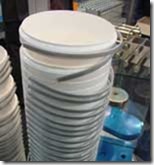 HDPE polyethylene (high density) is used mainly for the production of containers and packaging. Abroad, about a third of the polymer produced is used for the manufacture of blow molded containers (containers for food products, perfumery and cosmetic products, automotive and household chemicals, fuel tanks and barrels). It should be noted that in comparison with other areas, the use of HDPE for the production of packaging films is growing at an outstripping pace. PE ND is also used in the production of pipes and pipeline parts, where such advantages of the material as durability (service life - 50 years), simplicity of butt welding, low cost (on average 30% lower than in
HDPE polyethylene (high density) is used mainly for the production of containers and packaging. Abroad, about a third of the polymer produced is used for the manufacture of blow molded containers (containers for food products, perfumery and cosmetic products, automotive and household chemicals, fuel tanks and barrels). It should be noted that in comparison with other areas, the use of HDPE for the production of packaging films is growing at an outstripping pace. PE ND is also used in the production of pipes and pipeline parts, where such advantages of the material as durability (service life - 50 years), simplicity of butt welding, low cost (on average 30% lower than in 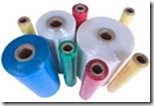 LDPE polyethylene (low density) is used mainly in the production of food, technical, agricultural films and for insulation of pipelines. IN
LDPE polyethylene (low density) is used mainly in the production of food, technical, agricultural films and for insulation of pipelines. IN 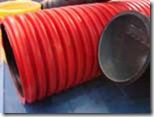 Pipes. Of all types of plastics, PE has found the greatest application for the manufacture of extrusion and centrifugal casting of pipes, characterized by lightness, corrosion resistance, insignificant resistance to fluid movement, ease of installation, flexibility, frost resistance, ease of welding.
Pipes. Of all types of plastics, PE has found the greatest application for the manufacture of extrusion and centrifugal casting of pipes, characterized by lightness, corrosion resistance, insignificant resistance to fluid movement, ease of installation, flexibility, frost resistance, ease of welding. 